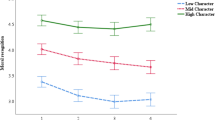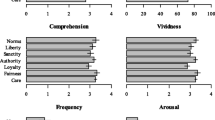Abstract
In 1991, Jones developed an issue-contingent model of ethical decision making in which moral intensity is posited to affect the four stages of Rest’s 1986 model (awareness, judgment, intention, and behavior). Jones claimed that moral intensity, which is “the extent of issue-related moral imperative in a situation” (p. 372), consists of six characteristics: magnitude of consequences (MC), social consensus (SC), probability of effect (PE), temporal immediacy (TI), proximity (PX), and concentration of effect (CE). This article reports the findings of two studies that analyzed the factor structure of moral intensity, operationalized by a 12-item Perceived Moral Intensity Scale (PMIS) adapted from the work of Singhapakdi et al. [1996, Journal of Business Research, 36, 245–255] and Frey [2000, Journal of Business Ethics, 26, 181–195]. The two items that were purported to measure CE were dropped due to their inability to effectively tap into the characteristic proposed by Jones. Factor analyses of the remaining 10 items supported a 3-factor structure, with the MC, PE, and TI items loading on the first factor, the PX items loading on the second factor, and the SC items loading on the third factor. These factors were labeled: Probable Magnitude of Consequences, Proximity, and Social Consensus. The authors conclude that moral intensity consists of three characteristics, rather than the six posited by Jones.
Similar content being viewed by others
Abbreviations
- CE:
-
Concentration of Effect
- CFA:
-
Confirmatory Factor Analysis
- EFA:
-
Exploratory Factor Analysis
- F:
-
Factor
- MC:
-
Magnitude of Consequences
- MI:
-
Moral Intensity
- MIS:
-
Moral Intensity Scale
- PE:
-
Probability of Effect
- PMIS:
-
Perceived Moral Intensity Scale
- PX:
-
Proximity
- R 2 :
-
Communality
- SC:
-
Social Consensus
- TI:
-
Temporal Immediacy
References
C. S. Alexander H. J. Becker (1978) ArticleTitle‘The Use of Vignettes in Survey Research’ Public Opinion Quarterly 42 93–104 Occurrence Handle10.1086/268432
D. J. Brass K. K. Butterfield B. C. Skaggs (1998) ArticleTitle‘Relationships and Unethical Behavior: A Social Network Perspective’ Academy of Management Review 23 14–31
K. D. Butterfield L. K. Trevino G. R. Weaver (2000) ArticleTitle‘Moral Awareness in Business Organizations: Influences of Issue-Related and Social Context Factors’ Human Relations 53 981–1018
P. A. Dabholkar J. J. Kellaris (1992) ArticleTitle‘Toward Understanding Marketing Students’ Ethical Judgment of Controversial Personal Selling Practices’ Journal of Business Research 24 313–329 Occurrence Handle10.1016/0148-2963(92)90037-C
L. M. Dawson (1995) ArticleTitle‘Women and Men, Morality and Ethics’ Business Horizons 38 61–68 Occurrence Handle10.1016/0007-6813(95)90010-1
A. J. Dubinsky B. Loken (1989) ArticleTitle‘Analyzing Ethical Decision Making in Marketing’ Journal of Business Research 19 83–107 Occurrence Handle10.1016/0148-2963(89)90001-5
O. C. Ferrell L. G. Gresham (1985) ArticleTitle‘A Contingency Framework for Understanding Ethical Decision Making in Marketing’ Journal of Marketing 49 87–96
O. C. Ferrell L. G. Gresham J. Fraedrich (1989) ArticleTitle‘A Synthesis of Ethical Decision Models for Marketing’ Journal of Macromarketing 11 55–64
B. F. Frey (2000) ArticleTitle‘The Impact of Moral Intensity on Decision Making in a Business Context’ Journal of Business Ethics 26 181–195 Occurrence Handle10.1023/A:1006139124110
D. J. Fritzsche (1995) ArticleTitle‘Personal Values: Potential Keys to Ethical Decision Making’ Journal of Business Ethics 14 909–922 Occurrence Handle10.1007/BF00882069
D. J. Fritzsche H. Becker (1984) ArticleTitle‘Linking Management Behavior to Ethical Philosophy – An Empirical Investigation’ Academy of Management Journal 27 166–175
J. R. Harris (1990) ArticleTitle‘Ethical Values of Individuals at Different Levels in the Organizational Hierarchy of a Single Firm’ Journal of Business Ethics 9 741–750
Harvey, R. J.: 1982, A New Approach to Job Classification Using Two-Mode Factor Analysis. (Doctoral Dissertation, Ohio State University, 1982), Dissertation Abstracts International, 43, 5-B, 1649.
L. Hatcher (1994) A Step-by-Step Approach to Using the SAS System for Factor Analysis and Structural Equation Modeling SAS Institute Inc Cary, NC
J. J. Hoffman (1998) ArticleTitle‘Are Women Really More Ethical Than Men? Maybe It Depends On the Situation’ Journal of Managerial Issues 10 60–73
S. D. Hunt S. Vitell (1986) ArticleTitle‘A general theory of marketing ethics’ Journal of Macromarketing 6 5–16
T. M. Jones (1991) ArticleTitle‘Ethical Decision Making by Individuals in Organizations: An Issue-Contingent Model’ Academy of Management Review 16 366–395
D. Kahneman P. Slovic A. Tversky (Eds) (1982) Judgment Under Uncertainty: Heuristics and Biases Cambridge University Press Cambridge
P. C. Kelly D. R. Elm (2003) ArticleTitle‘The Effect of Context on Moral Intensity of Ethical Issues: Revising Jones’s Issue-Contingent Model’ Journal of Business Ethics 48 139–154
J. Levin (1965) ArticleTitle‘Three-mode Factor Analysis’ Psychological Bulletin 64 442–452
D. R. May K. P. Pauli (2002) ArticleTitle‘The Role of Moral Intensity in Ethical Decision Making’ Business & Society 41 84–117 Occurrence Handle10.1177/0007650302041001006
D. L. McCabe J. M. Dukerich J. E. Dutton (1991) ArticleTitle‘Context, Values and Moral Dilemmas: Comparing the Choices of Business and Law School Students’ Journal of Business Ethics 10 951–960 Occurrence Handle10.1007/BF00383799
J. Nunnally (1978) Psychometric Theory McGraw-Hill New York
R. E. Reidenbach D. P. Robin L. Dawson (1991) ArticleTitle‘An Application and Extension of a Multidimensional Ethics Scale to Selected Marketing Practices and Marketing Groups’ Journal of the Academy of Marketing Science 19 IssueID2 83–92
J. R. Rest (1986) Moral Development: Advances in Research and Theory Praeger New York
SAS Institute, Inc.: 1999, SAS/STAT user’s guide: The factor procedure. Retrieved July 12, 2004, from http://www.id.unizh.ch/software/unix/statmath/sas/sasdoc/stat/chap26/ sect23.htm.
A. Singhapakdi S. J. Vitell K. L. Kraft (1996) ArticleTitle‘Moral Intensity and Ethical Decision-making of Marketing Professionals’ Journal of Business Research 36 245–255 Occurrence Handle10.1016/0148-2963(95)00155-7
W. E. Stead D. L. Worrell J. G. Stead (1990) ArticleTitle‘An Integrative Model for Understanding and Managing Ethical Behavior in Business Organizations’ Journal of Business Ethics 9 233–242 Occurrence Handle10.1007/BF00382649
M. D. Street S. C. Douglas S. W. Geiger M. J. Martinko (2001) ArticleTitle‘The Impact of Cognitive Expenditure on the Ethical Decision-making Process: The Cognitive Elaboration Model’ Organizational Behavior and Human Decision Processes 86 256–277 Occurrence Handle10.1006/obhd.2001.2957
L. K. Trevino (1986) ArticleTitle‘Ethical Decision Making in Organizations: A Person–Situation Interactionist Model’ Academy of Management Review 11 601–617
L. R. Tucker (1966) ArticleTitle‘Some Mathematical Notes on Three-mode Factor Analysis’ Psychometrika 31 279–311
S. Valentine L. Silver (2001) ArticleTitle‘Assessing the Dimensionality of the Singhapakdi, Vitell, and Kraft Measure of Moral Intensity’ Psychological Reports 88 291–294 Occurrence Handle10.2466/PR0.88.1.291-294
J. M. Zych (1999) ArticleTitle‘Integrating Ethical Issues with Managerial Decision Making in the Classroom: Product Support Program Decisions’ Journal of Business Ethics 18 255–266 Occurrence Handle10.1023/A:1005871423821
Author information
Authors and Affiliations
Corresponding author
Rights and permissions
About this article
Cite this article
McMahon, J.M., Harvey, R.J. An Analysis of the Factor Structure of Jones’ Moral Intensity Construct. J Bus Ethics 64, 381–404 (2006). https://doi.org/10.1007/s10551-006-0006-5
Issue Date:
DOI: https://doi.org/10.1007/s10551-006-0006-5




